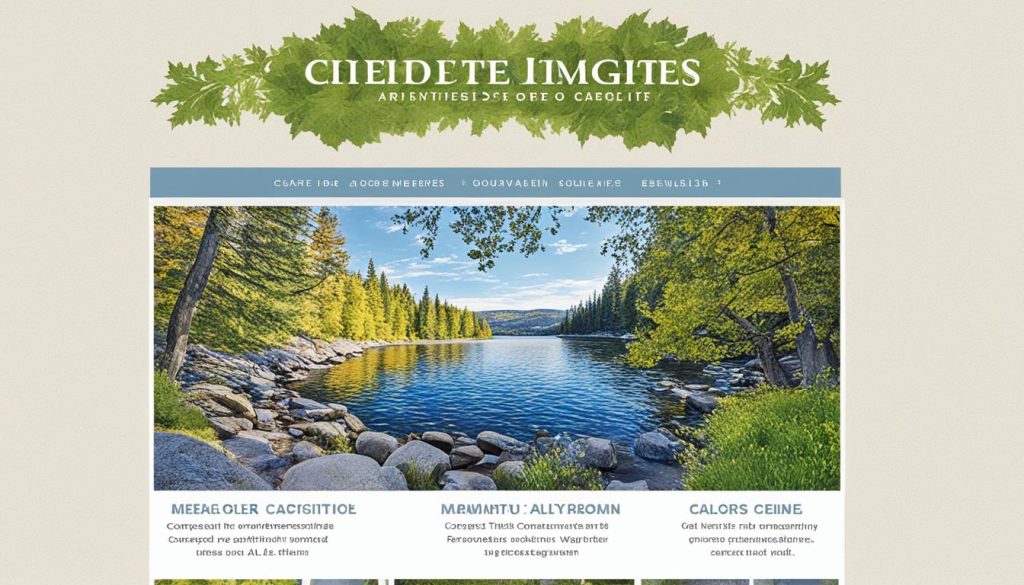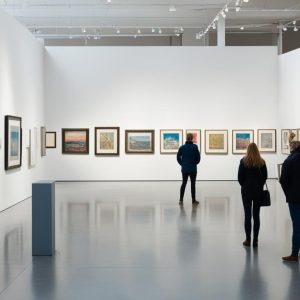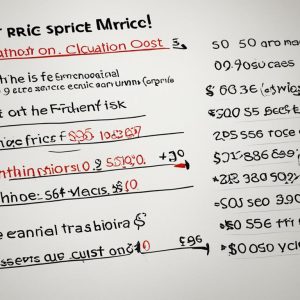As an artist, I understand the importance of having a strong online presence. In today’s digital world, it’s crucial to optimize your art website for search engines, so you can reach a wider audience and attract more visitors. That’s where SEO comes in.
SEO, or search engine optimization, is a set of techniques that can improve your website’s visibility on search engine result pages. By implementing effective SEO strategies, you can increase your chances of appearing higher in search results when potential clients or art enthusiasts are searching for artists or artwork like yours.
In this guide, I will explore various SEO techniques tailored specifically for artists. Whether you’re a painter, sculptor, photographer, or any other type of artist, these strategies will help you optimize your website, improve your online visibility, and ultimately, attract more potential buyers and art enthusiasts to your work.
Let’s dive into the world of SEO for artists and learn how you can improve your website’s visibility and reach a wider audience.
Key Takeaways:
- Implementing SEO strategies can significantly improve an artist’s website visibility.
- SEO techniques help artists attract a wider audience and reach potential buyers or art enthusiasts.
- Optimizing your website is essential for improving search engine rankings and increasing organic traffic.
- By utilizing keywords effectively and creating quality content, artists can enhance their online presence.
- Leveraging image SEO and building quality backlinks can further boost an artist’s visibility and search engine rankings.
Understanding the Importance of SEO for Artists
As an artist, your online visibility plays a significant role in reaching a wider audience and showcasing your work. This is where search engine optimization (SEO) comes in. By utilizing art SEO services and implementing artist SEO techniques, you can improve your website’s search engine rankings and attract your target audience.
Optimizing your website for search engines is an essential component of your overall artist marketing strategy. It helps you generate organic traffic and enhances your online presence, making it easier for art enthusiasts and potential clients to discover your work.
With the right art SEO services, you can leverage techniques like keyword optimization, content creation, and backlink building to increase your website’s visibility. By appearing higher in search engine results, you can capture the attention of your target audience and drive more traffic to your website.
Investing in artist SEO techniques allows you to stand out among the vast pool of creative professionals. By implementing strategies tailored specifically for artists, you can ensure that your website is optimized to its fullest potential, allowing your art to shine and resonate with your audience.
Remember, your website acts as your online portfolio, showcasing your talent and creativity. By utilizing art SEO services and implementing artist SEO techniques, you can ensure that your website is easily discoverable by search engines and art enthusiasts alike.
“Art SEO services and artist SEO techniques are powerful tools that help you improve your search engine rankings and increase your online visibility.” – Emma Davis, SEO Specialist
The Benefits of SEO for Artists
- Increase your website’s visibility and reach a wider audience
- Generate organic traffic to your website
- Improve your search engine rankings and outrank competitors
- Enhance your online presence and brand recognition
- Attract your target audience and potential clients
By understanding the importance of SEO for artists and implementing effective strategies, you can take your online presence to new heights. Stay tuned as we explore different techniques to optimize your art website in the next sections.
Optimizing Your Website Structure for SEO
A well-structured website is crucial for effective art website SEO. As artists, we need to ensure that our websites are user-friendly and offer easy navigation to our visitors. A cluttered and confusing website layout can discourage users from exploring further and affect our search engine rankings.
One important aspect of optimizing our website structure is organizing our artwork or projects into well-defined categories. By doing so, we make it easier for users to find the specific content they are interested in. For instance, if I specialize in landscape paintings and abstract sculptures, I should have separate categories or sections dedicated to each style.
Mobile optimization is also crucial in today’s digital landscape. With the majority of users accessing content via mobile devices, it is essential that our websites are responsive and mobile-friendly. This means ensuring that the website elements are properly scaled and displayed on smaller screens, without sacrificing the user experience. Google also considers mobile-friendliness as a ranking factor, so it is important to prioritize this aspect of seo for creative professionals.
I realized the importance of optimizing my website structure when I reorganized the categories of my photography portfolio. By creating distinct sections for landscapes, portraits, and street photography, I noticed a significant improvement in user engagement and search engine rankings.
When optimizing our website for SEO, it is essential to focus on improving navigation. A clear and intuitive navigation menu allows users to easily explore different sections of our website and find the relevant content they are looking for. Consider using descriptive labels for menu items, avoiding jargon or ambiguous terms.
Another important aspect is ensuring that our website has a logical hierarchy. This means arranging our content in a way that flows naturally, from broad categories to more specific subcategories or individual pieces. This not only helps visitors find what they are looking for but also helps search engines understand the structure of our website.
- Create a main navigation menu that is prominently displayed on every page.
- Utilize drop-down menus to organize subcategories or related content.
- Include a search bar for users to quickly find specific artwork or projects.
The Importance of Sitemaps
Sitemaps play a crucial role in optimizing website structure for SEO. A sitemap is a file that lists all the pages on our website, making it easier for search engines to crawl and index our content. By submitting our sitemap to search engines, we ensure that our website is fully understood and indexed.
“Implementing a sitemap on my website was a game-changer for improving SEO. Search engines could easily discover and index all my artwork, resulting in improved visibility in search results.”
There are different types of sitemaps, including HTML, XML, and image sitemaps. XML sitemaps are specifically designed for search engines, while HTML sitemaps are useful for users to navigate our website. Including an image sitemap is important for ensuring that search engines understand and index our visual content.
In conclusion, optimizing our website structure is vital for effective art website SEO and improving our search engine rankings. By creating a user-friendly and well-organized website, implementing clear navigation, and utilizing sitemaps, we can enhance the user experience and make it easier for search engines to discover and index our content.
Utilizing Keywords Effectively
Researching and incorporating relevant keywords is a fundamental aspect of SEO for artists. As an artist, understanding the keywords that potential clients or art enthusiasts might use to find your type of work is essential in improving your online visibility and website SEO.
By identifying these keywords, you can optimize various elements on your website, including titles, descriptions, and image alt tags. This helps search engines better understand and index your content, leading to improved search rankings and increased online visibility for your artwork.
Implementing Effective Keyword Research
When researching keywords, consider the specific niche or style of art you specialize in. Think about the terms someone may use when searching for art similar to yours.
Utilize keyword research tools like Google Keyword Planner, Moz Keyword Explorer, or SEMrush to identify popular and relevant keywords in your art market. These tools provide insights into search volume, competition, and related keywords.
For example, if you are a painter specializing in landscapes, some relevant keywords could be “nature paintings,” “landscape art,” or “scenic artwork.”
Optimizing Website Elements with Keywords
Once you have identified your keywords, it’s time to incorporate them strategically into your website. Here are key areas where you should include your target keywords:
- Title tags: Ensure your page titles accurately describe the content and include relevant keywords. For example, “Stunning Nature Paintings: Landscape Art by [Your Name].”
- Meta descriptions: Write concise and compelling descriptions for your pages, incorporating your keywords naturally.
- Image alt tags: Use descriptive alt tags for your artwork images, including relevant keywords. This helps search engines understand the image content and improves accessibility for visually impaired users.
- Heading tags: Incorporate keywords into your headings and subheadings (H1, H2, H3) when relevant and suitable, while maintaining a natural flow.
- Website copy: Write engaging and informative content that incorporates your keywords naturally. Avoid keyword stuffing, as it can harm your SEO.
Remember, optimizing your website with keywords is not about overusing them. It’s about creating quality content and providing valuable information that resonates with your target audience.
By utilizing keywords effectively, you can improve your online visibility, attract more visitors to your website, and increase the chances of turning them into loyal fans or buyers of your artwork.
Creating Quality Content for SEO
Regularly updating your website with quality content is essential for effective SEO. Search engines favor websites with fresh, relevant content, so it’s important to keep your website up to date and engaging. One effective way to do this is by maintaining a blog where you can showcase your creative process, share insights about your industry, and provide updates on your upcoming projects.
By regularly publishing blog posts, you can attract more visitors to your website and increase its visibility. Not only does quality content help you rank higher in search engine results, but it also encourages visitors to stay on your site longer and increases the likelihood of shares and backlinks. Both of these factors contribute to improved SEO rankings and overall website visibility.
“A well-curated blog can be a powerful tool for artists to connect with their audience and establish themselves as experts in their field.”
When creating content for your blog, it’s essential to provide value to your readers. Consider sharing insights and tips about your artistic process, discussing industry trends, or providing tutorials and guides related to your art form. By offering useful and engaging content, you can attract a wider audience and build a loyal following.
In addition to blog posts, you can also create other types of content to improve your website’s visibility. This can include videos showcasing your artwork, interviews with fellow artists, or behind-the-scenes glimpses into your creative process. Diversifying your content not only keeps your website fresh and engaging but also helps attract different types of visitors.
Benefits of Creating Quality Content for SEO
- Improved website visibility and search engine rankings.
- Increased organic traffic to your website.
- Longer visitor duration and lower bounce rate.
- Increase in social media shares and backlinks.
- Establishment of authority and expertise in your artistic field.
By leveraging artist SEO techniques and consistently creating quality content, you can enhance your website’s visibility, grow your online audience, and establish yourself as a reputable artist in your field. Remember, offering valuable and engaging content not only helps you improve your SEO rankings but also contributes to creating meaningful connections with your audience.

Leveraging Image SEO
Images are a powerful tool for showcasing an artist’s work and attracting potential buyers. However, it’s essential to optimize these images for SEO to improve online visibility.
One crucial aspect of image SEO is using descriptive alt tags for each image. By incorporating relevant keywords into the alt tags, artists can enhance search engine indexing and improve accessibility. For example, instead of using generic alt text like “image_01.jpg,” include descriptive keywords related to the artwork or the artist’s style.
Another important consideration is image compression. Optimizing images for web use helps to reduce file sizes, resulting in faster loading times. This is crucial because website speed is a critical SEO factor. By using compression techniques without compromising image quality, artists can provide a seamless user experience while still maintaining optimal loading times.
To further enhance image SEO, it is recommended to use high-resolution images that accurately represent the artwork. This allows visitors to appreciate the details and quality of the pieces.

Optimizing images is an integral part of overall SEO strategies for artists. By using descriptive alt tags, compressing images for faster loading times, and providing high-resolution visuals, artists can effectively improve their online visibility and attract more visitors to their websites.
Building Quality Backlinks and Utilizing Social Media
Building quality backlinks is an essential aspect of improving SEO for artists. Collaborating with other creatives, guest posting on reputable sites, and submitting your work to online galleries with high domain authority can help you build a strong backlink profile. By establishing connections within the art community and showcasing your work on respected platforms, you can enhance your online visibility and increase your chances of being discovered by a wider audience.
Additionally, social media platforms like Instagram, Pinterest, and LinkedIn can play a pivotal role in your artist marketing strategies. These platforms provide opportunities to share your work, engage with your audience, and indirectly boost your SEO efforts. By regularly posting updates, sharing your artwork, and linking back to your website, you can attract more visitors and increase your online visibility.
Remember to optimize your social media profiles by using relevant keywords in your bio, captions, and hashtags. This will help search engines index your social media content and improve its visibility in search results. Engaging with other artists and art enthusiasts by commenting on their posts and actively participating in relevant communities can also contribute to growing your social media presence and expanding your network.
Conclusion
In conclusion, implementing SEO strategies tailored specifically for artists is crucial for improving their website’s visibility and attracting a wider audience. By optimizing the website structure, utilizing keywords effectively, creating quality content, leveraging image SEO, building quality backlinks, and utilizing social media platforms, artists can significantly enhance their online presence.
Consistent efforts in optimizing their art website’s SEO will lead to increased visibility, more organic traffic, and ultimately, more opportunities for their work to be discovered and appreciated. With proper SEO for artists and artist website optimization, artists can showcase their creativity to a larger audience and establish a strong online brand.
Remember, SEO is an ongoing process, and it requires dedication and continuous effort. By keeping up with the latest SEO trends and regularly updating your website with fresh content, you can stay ahead of the competition and maximize your online visibility. Embrace SEO as a valuable tool in your artistic journey and watch as it helps your work reach new heights.
FAQ
What is SEO and why is it important for artists?
How can artists optimize their website structure for SEO?
How can artists effectively utilize keywords for SEO?
Why is creating quality content important for SEO?
How can artists optimize images for SEO?
Share this content:






